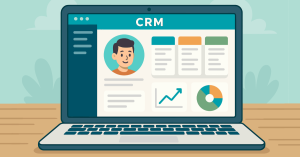The modern marketer is constantly looking for strategies to optimize their campaigns. It’s not enough to know what works—you need to understand why it works. That means going beyond vanity metrics and last-click attribution, a model that gives all the credit for a conversion to the last click that led to it, to fully understand how your campaigns influence real revenue outcomes.
This is where multi-touch attribution steps in.
When executed effectively, multi-touch attribution unveils the entire customer journey – from the initial interaction to the final transaction. This comprehensive understanding empowers you to reinforce what drives conversions and eliminate what doesn’t. However, without the right data, your attribution model is navigating in the dark.
In this article, we’ll talk about how connecting CRM data like lead source, lifecycle stage, and opportunity status with engagement data from your marketing automation platform (MAP) gives you the visibility you need to optimize campaigns that actually move the needle.
Why Multi-Touch Attribution Matters Now More Than Ever
Buyers are typically exposed to dozens of touchpoints across email campaigns, ads, social content, webinars, gated assets, and more before making a buying decision. Each one of these touchpoints plays a role in nudging those buyers closer to a sale.
If you’re only attributing revenue to the last touch (say, an ad-click or a demo request), you’re missing the forest for the trees. That early-stage blog post, mid-funnel nurture email, and retargeting ad helped seal the deal.
A true multi-touch attribution model accounts for the entire journey, distributing credit across multiple interactions and helping marketers:
- Understand which channels work best (and when)
- Optimize spend across touchpoints
- Tailor content to the right stage of the funnel
- Align sales and marketing with shared revenue insights
CRM Data: The Backbone of Attribution
Your CRM holds the story of each lead’s progression – from unknown visitor to paying customer. When you sync that story with the behavioral data in your MAP, you create a closed-loop view of the customer journey.
Here’s how key CRM data points can supercharge your attribution efforts:
Lead Source
It starts at the beginning. Knowing how a lead entered your universe, whether from organic search, paid social, referral, or a trade show, gives you first-touch attribution clarity.
Example: A lead enters via a webinar (captured in your CRM), later engages with multiple nurture emails (logged in your MAP), and finally converts after a product comparison page visit. With both systems connected, you can assign value to every step, not just the last click.
Lifecycle Stage
Understanding where a contact is in the funnel (lead, MQL, SQL, opportunity, or customer) helps you map which campaigns influence stage progression.
Example: Your MAP records a click-through on a mid-funnel case study. Meanwhile, your CRM shows the lead moved from MQL to SQL a day later. Coincidence? Probably not. That content touch likely played a role – and attribution models can now reflect that.
Opportunity and Revenue Data
This is the payoff. By tying campaign interactions to actual revenue outcomes in the CRM, you move from “this email had a 30% open rate” to “this campaign influenced $75,000 in the pipeline.”
Example: Your CRM shows a deal worth $20,000 closed last month. By tracing that contact’s MAP engagement history, you see five different touchpoints across three campaigns. Now, you can attribute a percentage of that revenue to each one – not just the last-touch form fill.
How Integrated Systems Power Smarter Attribution
When your CRM and MAP work together, you get more than just clean data – you get actionable insight.
Here’s what that looks like in practice:
- Campaign Optimization: With full visibility into how different channels and content pieces contribute to pipeline, you can fine-tune your campaigns for maximum ROI. No more guessing which asset works best – now you have the data to prove it.
- Budget Allocation: See which channels are influencing deals at different stages and allocate budget accordingly. Maybe search drives top-funnel traffic, but email nurtures more leads into SQLs. Now you know where to spend smarter.
- Sales and Marketing Alignment: When both teams can trace the path from campaign to closed deal, it’s not just about speaking the same language. It’s about working together towards a common goal. Marketing gets credit for real revenue influence, and sales get warmer leads nurtured with purpose-built content.
Attribution Without CRM is Just a Guess
Multi-touch attribution isn’t about assigning credit for the sake of bragging rights. It’s about understanding what works, what doesn’t, and how to do better next time. But without the context your CRM provides, your MAP is only telling half the story.
At emfluence, we believe your data should work for you – not the other way around. That’s why our platform makes it easy to connect with leading CRMs like Salesforce and Microsoft Dynamics, which will help you build a marketing machine that’s smarter and more effective.
Learn More
To learn more about how the marketing experts at emfluence can help you become a smarter, more effective marketer by combining the power of your CRM and MAP data, contact us today via expert@emfluence.com.


